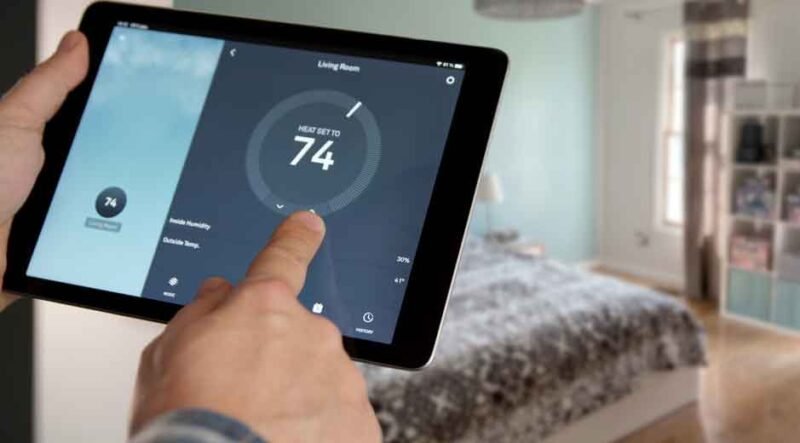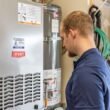In the modern era of home comfort, smart thermostats have revolutionized the way households manage heating systems. These devices are not just about convenience; they fundamentally change how furnaces operate and how often they may require repair or maintenance. By learning household routines, automatically adjusting temperatures, and providing precise energy usage data, smart thermostats can prevent common issues that arise from inconsistent furnace operation. Homeowners who integrate smart thermostats often notice improved system longevity and efficiency. We will explore how this technology impacts furnace repair service needs, highlighting both the advantages and potential considerations homeowners should be aware of when upgrading their heating systems.
Impact of Smart Thermostats on Furnace Maintenance and Repairs
- Improved Energy Efficiency and Reduced Strain
Smart thermostats optimize furnace cycles by adjusting heating patterns based on occupancy, outdoor temperatures, and daily schedules. Traditional thermostats rely on manual adjustments, which often lead to longer runtime and unnecessary strain on the furnace. Excessive runtime can accelerate wear and tear on components such as the blower motor, heat exchanger, and ignition system. With a smart thermostat, the furnace operates only when necessary, reducing mechanical stress and potentially lowering the frequency of repairs. Homeowners seeking furnace repair in Silver Spring may notice fewer breakdowns because the furnace operates more consistently and efficiently, avoiding overuse. Over time, this energy-conscious approach also translates into lower utility bills, making the investment in a smart thermostat beneficial both for system longevity and household finances.
- Proactive Issue Detection Through Diagnostics
Many smart thermostats now come with features that monitor furnace performance and alert homeowners to irregularities, such as unusual temperature fluctuations, excessive cycling, or airflow issues. This early detection allows for prompt intervention before minor problems escalate into major repairs. For example, if a furnace is struggling to maintain the programmed temperature, the thermostat can flag this issue, enabling a service call before the system fails entirely. Traditional systems lack this level of insight, often leaving homeowners unaware until a breakdown occurs. By identifying inefficiencies early, smart thermostats can reduce emergency repair calls and extend the functional lifespan of the furnace, helping homeowners maintain a more reliable heating environment year-round.
- Integration with Preventive Maintenance Schedules
Smart thermostats can track furnace usage and generate reminders for routine maintenance tasks, such as changing filters or scheduling professional inspections. Regular maintenance is crucial for preventing issues like clogged air filters, dirty burners, or worn-out components that can compromise system performance. The automated reminders encourage consistent upkeep, which can significantly reduce repair needs. Unlike manual systems, where maintenance may be overlooked, smart thermostats act as a scheduling assistant, keeping homeowners informed and accountable. By maintaining a proactive maintenance routine, furnaces experience fewer malfunctions, improve energy efficiency, and avoid costly emergency repairs that often occur when systems are neglected.
- Adaptation to Seasonal Changes
Furnaces often encounter stress during extreme weather, particularly during prolonged cold spells. Smart thermostats adjust heating schedules based on outdoor weather data, ensuring the system runs efficiently without overexertion. This reduces the likelihood of overheating or mechanical failure during periods of peak demand. Additionally, smart systems can gradually increase or decrease temperatures to avoid sudden surges that place unnecessary pressure on furnace components. By smoothing transitions and managing workload intelligently, these thermostats reduce the risk of damage and minimize the need for urgent repairs, creating a more stable environment for both the equipment and the household.
- Data-Driven Insights for Technicians
When a furnace does require professional attention, smart thermostats can provide technicians with detailed operational data, including runtime patterns, temperature trends, and error notifications. This information enables service providers to diagnose issues more quickly and accurately, thereby reducing the time spent on trial-and-error troubleshooting. Faster, data-informed repairs not only improve convenience for homeowners but also lower labor costs and prevent repeated visits. Furnaces also benefit, as problems are addressed promptly before they escalate into more serious damage. Overall, the integration of smart thermostats enhances both preventative and reactive aspects of furnace care, aligning with modern expectations for efficiency and reliability.
- Potential Considerations for Compatibility
While smart thermostats offer numerous benefits, homeowners should consider system compatibility before installation. Some older furnaces may not fully support advanced thermostat functions, potentially leading to miscommunication between devices or suboptimal performance. It is essential to verify that the selected smart thermostat is compatible with the existing furnace to prevent unnecessary stress or repair issues. Consulting with a heating service provider ensures proper setup, enabling the thermostat to manage the furnace effectively without introducing complications. Ensuring compatibility enhances energy efficiency, protects the system from undue strain, and maximizes the long-term benefits of a smart thermostat upgrade.
- Behavioral Influence on Furnace Usage
Smart thermostats also influence homeowner behavior by making energy use more visible and engaging. Many devices offer mobile apps or web dashboards that display real-time energy consumption, historical usage patterns, and cost estimates. This feedback encourages residents to make informed choices, such as adjusting the temperature when away from home or creating heating schedules that are tailored to their daily routines. By promoting responsible furnace usage, smart thermostats help prevent unnecessary wear and tear, thereby reducing the frequency of repairs. Over time, this behavioral change complements the mechanical advantages of the system, ensuring a well-maintained and energy-efficient home environment.
The introduction of smart thermostats has transformed the landscape of home heating, offering both operational and maintenance benefits that directly impact furnace repair needs. By optimizing energy usage, detecting issues early, supporting preventive maintenance, adapting to seasonal changes, and providing valuable data to technicians, these devices help reduce system strain and extend the lifespan of furnaces. Homeowners enjoy lower utility costs, fewer emergency repairs, and more consistent indoor comfort, while service providers gain clearer insights for efficient troubleshooting and repair. As technology continues to evolve, the partnership between smart thermostats and furnace systems represents a significant advancement in modern home comfort management, promoting reliability, efficiency, and proactive care.









